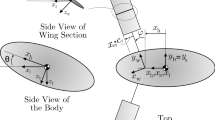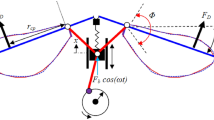Abstract
The hydrodynamic control laws of unsteady fins inspired by swimming and flying animals are considered. A controller based on cycle-averaged forces requires a bandwidth lower than the flapping frequency, with correspondingly slow reactions to disturbances or commands in order to avoid undesirable feedback from the oscillating fins. A harmonic model of the periodic thruster forces was empirically found using a mechanical fin flapping in roll and pitch in hover, in uniform flow, and under various kinematic conditions. A multi-fin vehicle could use this model to account for the dominant non-linearities and minimize undesirable motions through coordinated control of individual fins.










Similar content being viewed by others
References
Bandyopadhyay PR Guest (ed) (2004) Special issue on biology-inspired science and technology for autonomous underwater vehicles. IEEE J Oceanic Eng 29(3)
Bandyopadhyay PR (2005) Trends in biorobotic autonomous undersea vehicles. IEEE J Oceanic Eng 30:109–139
Bandyopadhyay PR, Beal DN, Menozzi A, Boller M (2008) Underwater vehicles close performance gaps with nature via exploitation of the high-lift principles of swimming and flying animals IEEE J Oceanic Eng 211(2) (in press)
Dickinson MH, Fritz-Olaf L, Sane SP (1999) Wing rotation and the aerodynamic basis of insect flight. Science 284:1954–1960
Ellington CP (1984) The aerodynamics of hovering insect flight, IV. Aerodynamic mechanisms. Phil Trans R Soc Ser B 305:79–113
Kato N, Liu H, Morikawa H (2005) Biology-inspired precision maneuvering of underwater vehicles–part 3. Intl J Offshore Polar Eng 15(2):81–87
Licht S, Polidoro V, Flores M, Hover FS, Triantafyllou MS (2004) Design and projected performance of a flapping foil AUV. IEEE J Oceanic Eng 29(3):786–794
Read DA, Hover FS, Triantafyllou MS (2003) Forces on oscillating foils for propulsion and maneuvering. J Fluids Struct 17:163–183
Videler JJ (1993) Fish swimming. Chapman & Hall, London
Acknowledgments
This work was sponsored by the Cognitive and Neuroscience Division of the Office of Naval Research (ONR 34, Program Officer Dr. Thomas McKenna) and the ONR/NUWC ILIR Program (Program Officer Mr. Richard Philips). Additionally, the authors would like to thank Dr. Alberico Menozzi and Mr. Henry Leinhos for discussions regarding the integration of the harmonic model into the NUWC biorobotic vehicle autopilot.
Author information
Authors and Affiliations
Corresponding author
Rights and permissions
About this article
Cite this article
Beal, D.N., Bandyopadhyay, P.R. A harmonic model of hydrodynamic forces produced by a flapping fin. Exp Fluids 43, 675–682 (2007). https://doi.org/10.1007/s00348-007-0352-9
Received:
Revised:
Accepted:
Published:
Issue Date:
DOI: https://doi.org/10.1007/s00348-007-0352-9




